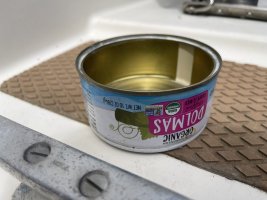Bolo
Contributing Partner
About a month ago, when it was still a bit cold in Maryland (not like today when it was almost ninety degrees) I was filling some holes in the cabin top that was were two winches were bolted through. So I used decided to use the “fast” hardener sold by West System. I normally use the “slow” hardener. I probably mixed a bit too much in the plastic mixing pot which I had sitting on a cutting board. After using the hypo to fill the holes I noticed steam or maybe smoke coming out of the plastic mixing pot. Realizing the epoxy was over heating by way of the curing process I panicked and picked up the pot instead of picking up the cutting board and the pot. Did I mention that I was doing this in the galley? As I quickly made my way into the cockpit the bottom of the pot started to give way splashing curing epoxy as I made my way to the dock. But then the bottom was really giving out so I pitched the whole thing into the water. Rushing back to find my plastic scraper I tried to remove as much curing epoxy from the cockpit wall and non-skid. Still much remained and I stopped because I was just spreading it out more.
So now that it’s cured and looking liked dried snot in the cockpit (sorry for the analogy but it’s really the best descriptio) how to get it off the gel coat and non-skid without damaging them in the process if that’s even possible? I did some reading and one site suggested careful use of a heat gun and plastics scraper. Another suggested using something cold, like refrigerant gas, to make the epoxy brittle that will allow it to be chipped off easier. As of right now I’m not sure what to try so I’m asking here. Ever had this issue? If so did you successfully get it off and how? Or if you never had this problem but know an answer or suggestion then please share and thanks.
So now that it’s cured and looking liked dried snot in the cockpit (sorry for the analogy but it’s really the best descriptio) how to get it off the gel coat and non-skid without damaging them in the process if that’s even possible? I did some reading and one site suggested careful use of a heat gun and plastics scraper. Another suggested using something cold, like refrigerant gas, to make the epoxy brittle that will allow it to be chipped off easier. As of right now I’m not sure what to try so I’m asking here. Ever had this issue? If so did you successfully get it off and how? Or if you never had this problem but know an answer or suggestion then please share and thanks.

 I would think that other methods would do more harm with a simple slip or misjudgment. This would take long enough to put you back in the good graces of any higher power that may exist.
I would think that other methods would do more harm with a simple slip or misjudgment. This would take long enough to put you back in the good graces of any higher power that may exist.
